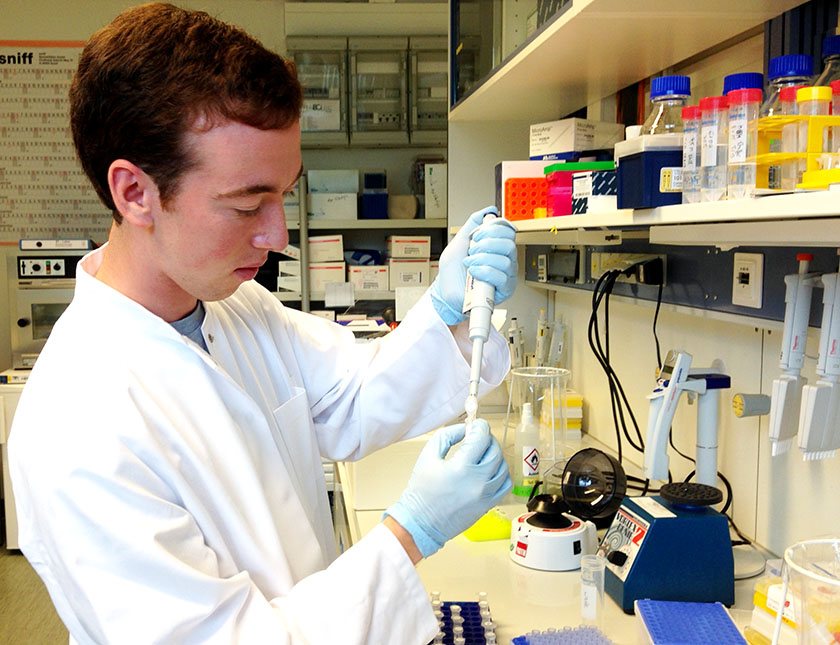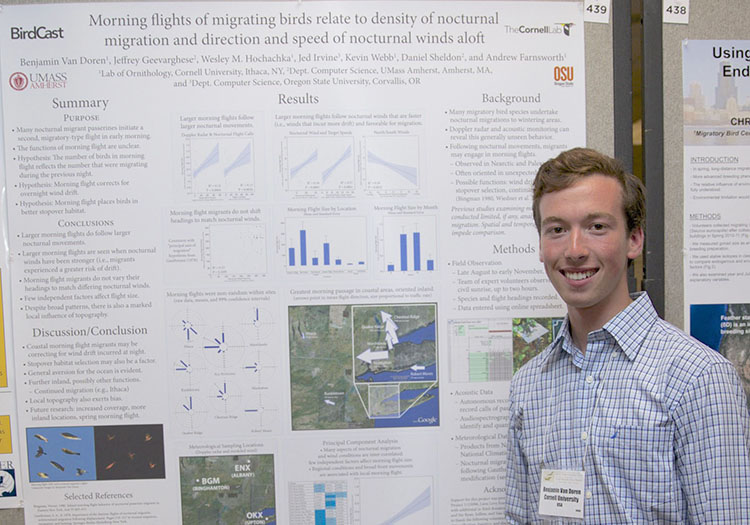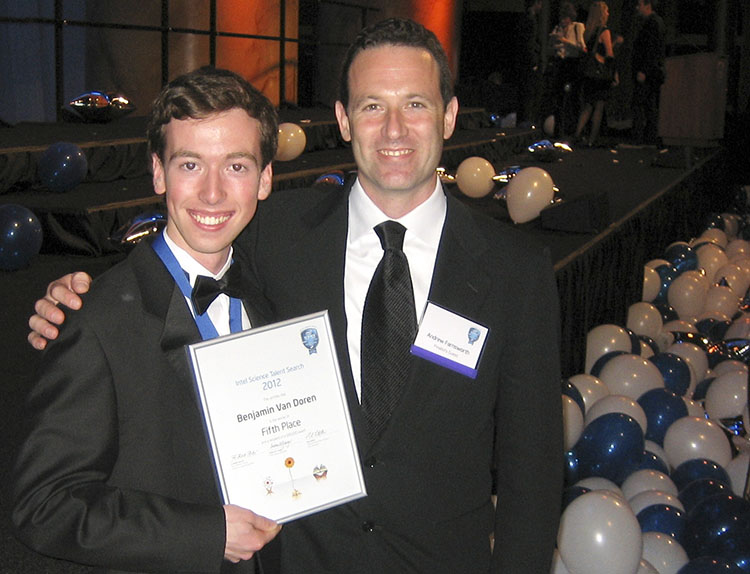Intel STS alum receives Marshall Scholarship

Intel Science Talent Search 2012 finalist Benjamin Van Doren recently won the 2016 Marshall Scholarship. Benjamin is a double major in biological sciences and biometry and statistics in the College of Agriculture and Life Sciences at Cornell University.
The scholarship provides funds for 40 U.S. students to pursue two years of graduate study at an institution in the United Kingdom, according to the Cornell Chronicle. The scholarship celebrates the humane ideals of the European Recovery Program or Marshall Plan, and thanks the U.S. for assistance Britain received after World War II. With the scholarship, Benjamin will pursue a graduate degree in ecology and evolutionary biology with a focus on bird migration in the Edward Grey Institute of Field Ornithology at Oxford University. The university is home to a renowned institute for ornithology, which is Benjamin’s area of specialty.
You were a part of the Cornell Lab of Ornithology’s BirdCast project on large-scale bird migration. Can you describe your role in this project? What was one of the weirdest or most interesting things you learned on this project?
Bird migration is among the natural world’s most amazing phenomena — billions of birds leave North America each fall and return in spring, often timing their flights to the day. The BirdCast project aims to quantify and predict these movements. Often, migration events are so massive that they show up on the National Weather Service’s long-range Doppler radars, just like rain or snow, and we can develop tools to track and quantify birds’ movements from radar data.
I’ve manually screened tens of thousands of radar images (to train our automated classifiers), helped analyze a large amount of data, and contributed to papers describing the patterns we observe. Studying bird migration with long-range radars has given me an appreciation for just how colossal the phenomenon really is. Anyone can witness the massive influx and exodus of birds in spring and fall, either by viewing radar imagery or by simply turning an ear to the sky: on cool autumn nights with northerly winds or warm spring nights with southerly winds, one can (in a quiet area) hear the calls of migrating birds drift down from high overhead.
Can you describe your involvement with the World Series of Birding and raising more than $150,000 for student research?
In the World Series of Birding, teams compete to find the most bird species possible in a 24-hour period in the state of New Jersey. The competition takes place in mid-May, the peak of spring bird migration in the northeast U.S. It’s possible to find over 250 species, but no team ever has enough time to find them all. Maximizing the number of species seen or heard means designing an efficient route that covers as many different habitats and eco-regions as possible. Sponsors donate money in support of our effort, and thanks to the Cornell Lab of Ornithology we reach many people.
I was a team captain in last year’s event. In the days before the competition, we fan out across the state to find particularly elusive species and refine the places we’ll visit on the day itself. Being a captain means integrating all of this information into an effective route, and sometimes making difficult decisions on game day. The event is fun, but the important part is that it makes possible the research and conservation projects of dozens of undergraduates at Cornell.

You went to Panama last year to study little-known rainforest birds. Can you describe your experience there?
I went with a small team of three undergraduates and an advisor to far eastern Panama — close to the Colombian border. This region, called the Darién, is one of the last truly wild places in Central America. We studied the mysterious Sapayoa, an unassuming greenish-brown bird that lives in dense rainforest. At first glance, this species may not seem like much, but its closest evolutionary relatives live half a world away in southeast Asia. We spent weeks tracking these birds and documenting their behavior and the rich wildlife of the region. Our work revealed many previously unknown aspects of their natural history — although exactly how their ancestors got to the Western Hemisphere in the first place remains a mystery.
What was your most memorable experience at Intel STS 2012?
I enjoyed so much of it. Being recognized on a national level in high school is something that can leave a lasting impression. More than anything, Intel STS reinforced in me the notion that hard work — and science — can truly pay off. If I had to choose what I remember most vividly right now, it would be a three-way tie: the awards presentation, meeting President Obama, and freezing up on a math question in one of the interview sessions.
Can you provide a description of your project?
My high school research examined a poorly-understood migratory behavior in birds, where those that typically migrate south in autumn instead head north and west. If this doesn’t sound odd enough, many of the species engaging in this behavior usually migrate exclusively at night — yet these “reverse” movements take place in the early morning, just after dawn. To figure out what was going on, I assembled a team of expert volunteer observers to document this phenomenon across the northeast U.S., and we used a suite of tools (e.g., Doppler weather radars, autonomous microphones, large-scale weather data) to see if birds’ behaviors and weather conditions during the nights preceding these morning movements could shed some light. We found evidence that birds are often pushed off course by winds during their normal nighttime migrations, and that these morning events are a type of correctional behavior to get them back on course. In particular, the results suggested that these songbirds were particularly keen to avoid the coast and the open ocean, likely because they can’t land on the water. Once I arrived at Cornell, I continued to improve this work, and it was published in a top ornithology journal.

Has your involvement in Intel STS influenced you to pursue STEM or promote STEM to others?
Throughout my life, I’ve found that I become most motivated and enthusiastic about ideas when I’m able to share them with like-minded peers. When I was in middle and high school I joined an organization of aspiring ornithologists, the New York State Young Birders Club, which gave my passion for birds and science a boost of energy. Likewise, Intel STS was a great opportunity for me to interact with peers with an incredible spread of interests and passions. The experience definitely increased my enthusiasm for pursuing science, and helped reaffirm my education and career goals.
Do you have other STEM-related projects or goals that you’re pursuing?
Ornithology is my primary field of interest, but a major goal of mine is to conduct research at an interdisciplinary and collaborative level, integrating ideas and technologies from many other fields. At Cornell I’m a double major in biology and statistics, and I’ve become very familiar with how valuable math is for conducting good science and gaining insight that would otherwise be impossible to achieve. I’m also interested in collaborating with engineers on future projects; for example, I would like to use state-of-the-art, miniaturized tracking devices to solve outstanding questions in my field. Overall, I plan to integrate many aspects of STEM into my work.
How did you become interested in science?
My parents gave me a field guide to birds when I was six. As I grew up, I was also interested in insects, rocks and minerals (I still have my collection), and astronomy. My third grade teacher Mrs. Conca had bird feeders outside our classroom windows and wove the science of identifying and counting birds into the curriculum — this is where my interest in birds really took off. I think my experience illustrates how important it is to give hands-on educational opportunities to young students, and to encourage them to pursue interests they have at a young age.
Do you have any advice to young people interested in science or math?
I would encourage young people interested in science to pursue what fascinates them — there is so much still to discover and explore in science and math. Studying birds has already given me opportunities to travel across the world, meet and work with amazing people, and have a lot of fun doing it.


